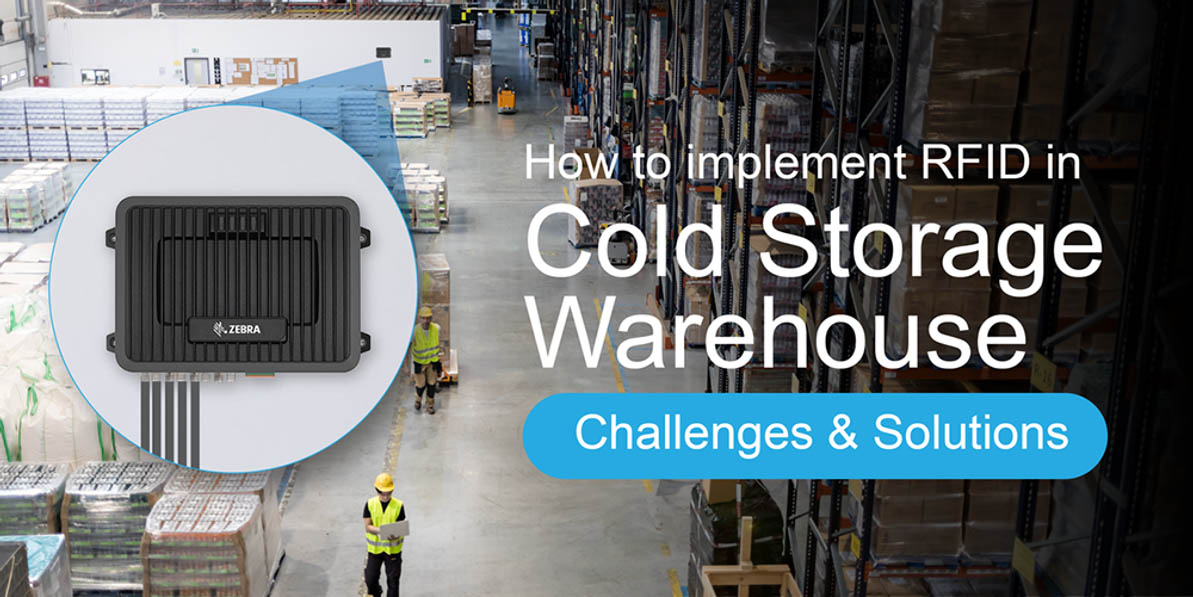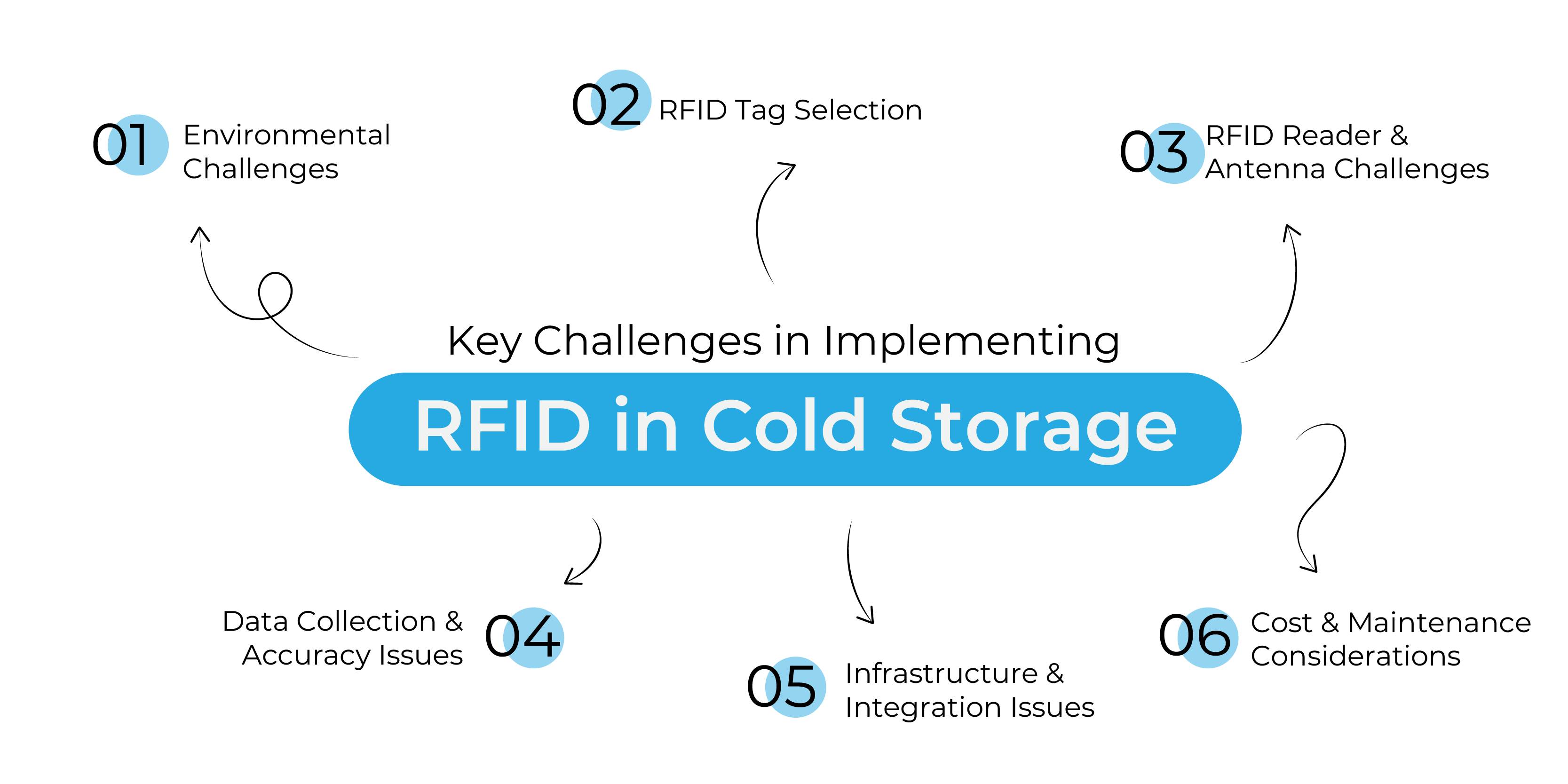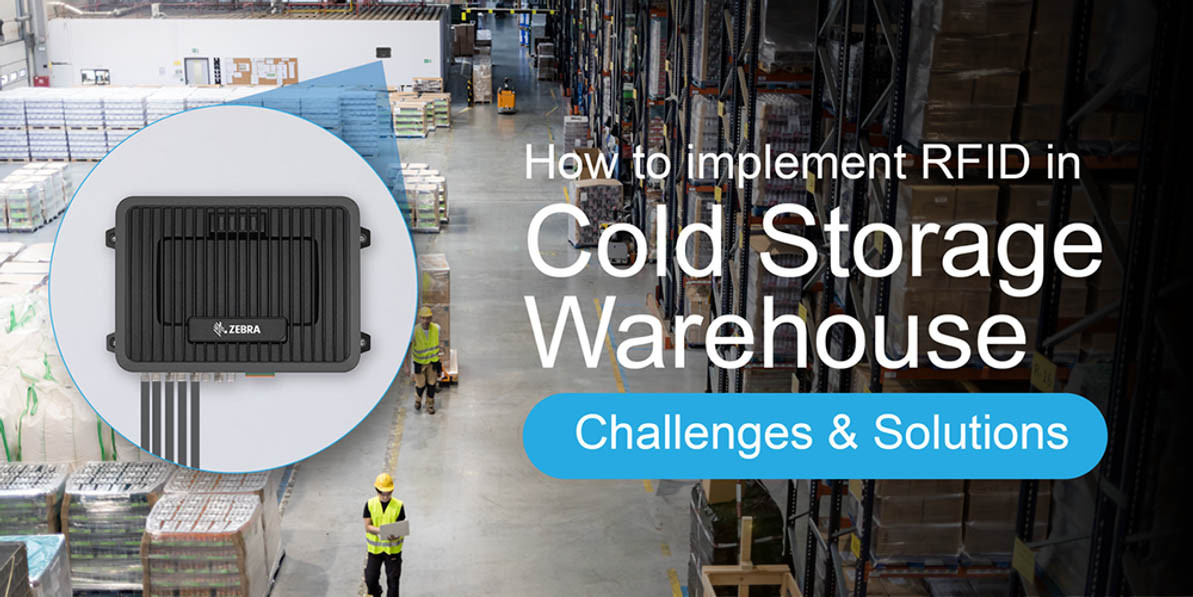How to implement RFID in Cold Storage Warehouse: Challenges and Solutions
Introduction
Radio Frequency Identification (RFID) technology plays a vital role in modern warehouse management, automating inventory tracking and reducing human errors. In cold storage warehouses, RFID enhances real-time tracking, inventory accuracy, and operational efficiency. However, implementing RFID in cold environments comes with unique challenges that need specialized solutions.

Understanding RFID in Cold Storage
What is RFID, and How Does It Work in Warehouse Environments?
RFID technology uses electromagnetic waves to identify and track assets. In warehouses, RFID tags are attached to inventory items, and RFID readers scan them to collect data. This system automates asset tracking, improves accuracy, and speeds up logistics operations.
Types of RFID Technology Used in Cold Storage:
Passive UHF RFID – Ideal for inventory tracking, offering long read ranges but affected by metal and moisture.
Active RFID – Equipped with a battery for real-time asset and temperature monitoring.
HF & LF RFID – Suitable for environments with metal-heavy storage or high moisture content.
Benefits of RFID in Cold Storage:

Automated Inventory Tracking
RFID enables real-time tracking of inventory, reducing the need for manual counting and ensuring accurate stock levels in cold storage environments.
Faster Audits and Cycle Counts
RFID speeds up audit processes by allowing bulk scanning of tagged items, minimizing downtime and improving operational efficiency.
Reduced Manual Errors
By automating data capture, RFID eliminates human errors associated with manual entry, ensuring accurate records and reducing inventory discrepancies.
Enhanced Traceability for Compliance
RFID provides detailed tracking of product movements, ensuring compliance with industry regulations and improving supply chain visibility for perishable goods.
Key Challenges in Implementing RFID in Cold Storage

1. Environmental Challenges
Extreme Temperatures: Standard RFID tags may become brittle and crack when exposed to freezing temperatures, leading to durability issues. Additionally, condensation buildup caused by temperature fluctuations can create moisture-related short circuits in RFID readers and antennas. Battery-powered RFID tags may also experience significantly reduced battery life in sub-zero environments, affecting long-term tracking reliability.
Moisture & Ice Accumulation: Water absorbs RFID signals, which leads to poor readability and reduced scanning accuracy in cold storage areas. Furthermore, adhesive RFID labels may fail to stick properly in freezing temperatures, requiring specialized cold-resistant adhesives for effective tagging.
2. RFID Tag Selection Challenges
Selecting the Right RFID Tags: RFID tags used in cold storage must be made from cold-resistant materials like polycarbonate or PET to withstand freezing temperatures. Additionally, encapsulation is required to prevent moisture ingress, which could damage the tag and affect performance. Metal and liquid-based products can also interfere with RFID signal strength, leading to reduced readability and tracking inefficiencies.
Choosing the Right Frequency: UHF RFID is best suited for pallet tracking due to its long read range, but it is highly sensitive to moisture, which can disrupt signal transmission. HF RFID performs better in liquid-heavy environments, such as frozen food storage, but has a shorter read range compared to UHF. LF RFID is the least affected by water interference, making it suitable for challenging conditions, but it has a very limited read range and slower data transmission.
3. RFID Reader & Antenna Challenges
Signal Interference Issues: Metal racks and dense storage structures can cause RFID signal reflections, leading to ghost reads or missed scans. Additionally, tightly stacked goods may block RFID waves, reducing read accuracy and making it difficult to track items efficiently.
Reader Placement Optimization: Fixed RFID readers should be strategically placed at dock doors and storage aisles to ensure proper scanning of incoming and outgoing inventory. In deep-freeze areas where fixed readers may struggle, handheld RFID readers may be necessary for improved scanning accuracy and flexibility.
Cold Store Hardware Durability: LCD screens on RFID handheld readers may freeze in extremely cold conditions, leading to malfunctions and readability issues. Furthermore, standard wiring used for RFID systems may become brittle and crack due to prolonged exposure to freezing temperatures, potentially causing connection failures.
4. Data Collection & Accuracy Issues
a. Read Accuracy Drops in Extreme Conditions
RFID Reads Affected by Frost: If ice accumulates on an RFID tag, it can obstruct signal transmission, making it difficult for readers to detect and scan the tag properly. This can lead to missing inventory data and tracking inconsistencies.
Stacked Goods Reduce Readability: In bulk shipments where items are tightly packed, RFID tags may become shadowed or blocked from the reader’s signal. This interference can cause incomplete scans, resulting in gaps in inventory tracking.
b. Duplicate or Missed Reads
RF Signal Reflection: Metal surfaces and moisture in cold storage environments can cause RFID signals to reflect, leading to ghost reads or duplicate scans. This can create data inaccuracies and confusion in inventory records.
Missed Reads Due to Fast Movement: When items move too quickly through the cold storage facility, RFID readers may fail to register their tags in time. This can result in missed scans, leading to discrepancies in inventory tracking and warehouse operations.
5. Infrastructure & Integration Issues
a. RFID System Integration with WMS/ERP
Cold storage warehouses often rely on Warehouse Management Systems (WMS) to streamline operations. To ensure seamless functionality, RFID technology must integrate efficiently with these systems. A well-integrated RFID solution enables real-time tracking of inventory, providing up-to-date stock levels without manual intervention. Automated inventory updates help in reducing human errors and improving operational efficiency. Additionally, RFID integration supports seamless order fulfillment, ensuring that shipments are accurately tracked and processed without delays.
b. Network Connectivity in Cold Environments
Maintaining stable network connectivity in cold storage environments is a challenge due to insulation and thick walls that can weaken Wi-Fi and RFID network signals. Wireless interference may lead to communication disruptions, affecting real-time inventory tracking. Cloud-based RFID systems require a stable internet connection to function effectively. Any network downtime can disrupt data synchronization, impacting inventory visibility and overall warehouse management.
c. Power Supply & Backup Concerns
Cold storage facilities must have power redundancy in place to prevent unexpected RFID system failures during sudden power outages. A reliable backup power system ensures that RFID readers and tracking systems continue to function without disruption. Additionally, low temperatures accelerate battery drain in handheld RFID readers and battery-powered active RFID tags. This can lead to frequent battery replacements, increasing maintenance efforts and costs.
6. Cost & Maintenance Considerations
a. Higher Costs for Cold-Resistant RFID Tags & Readers
RFID tags, readers, and antennas designed specifically for cold environments are generally more expensive than standard RFID components. These specialized devices are built to withstand extreme temperatures, moisture, and other challenging conditions in cold storage, which adds to their cost. However, investing in high-quality cold-resistant equipment is essential for maintaining reliable tracking and operational efficiency in such environments.
b. Maintenance Challenges
Battery-operated devices used in cold storage environments require frequent battery replacements due to rapid discharge in low temperatures. This increases both maintenance time and costs. Additionally, RFID readers and antennas in these environments are prone to ice buildup, which can obstruct signals and damage the hardware. Regular de-icing and cleaning of these devices are necessary to ensure optimal performance and to prevent system malfunctions.
Solutions for RFID Implementation in Cold Storage
1. Solutions for Environmental Challenges
- Use cold-resistant RFID tags made of PET, polycarbonate, or encapsulated plastic.
- Install IP67-rated RFID readers designed for freezing temperatures.
- Use cryogenic adhesives to ensure tags stay attached.
- Install waterproof enclosures around RFID readers to prevent moisture damage.
- Apply anti-frost coatings to RFID antennas and readers.
2. Solutions for RFID Tag Selection Challenges
a. Choose specialized cold-storage RFID tags like:
Selecting the right RFID tags is crucial for cold storage environments. Encapsulated RFID tags provide durability in freezing conditions. RFID hard tags, such as the TagMatiks RFID Hard Tag, offer robust performance for asset tracking. For extreme cold environments, cryogenic RFID labels ensure reliable scanning.
b. Optimize tag frequency selection:
Optimizing the RFID tag frequency is equally important. UHF RFID is best suited for general inventory tracking due to its long read range. HF RFID works effectively for products with high liquid content. LF RFID is ideal for applications involving metal-heavy storage and short-range scanning.
3. Solutions for RFID Reader & Antenna Challenges
- Use adjustable power RFID readers to prevent ghost reads.
- Install circular-polarized antennas to improve read performance.
- Optimize reader placement at entry points and aisles for maximum coverage.
4. Solutions for Data Collection & Accuracy Issues
- Use high-gain RFID antennas to improve read rates.
- Install multiple RFID read points to eliminate blind spots.
- Implement RFID middleware to filter duplicate reads.
5. Solutions for Infrastructure & Integration Issues
- Integrate RFID with WMS/ERP for real-time inventory tracking.
- Use PoE (Power over Ethernet) RFID readers to avoid power supply issues.
- Deploy Wi-Fi extenders inside cold storage to improve connectivity.
6. Solutions for Cost & Maintenance Challenges
- Start with a pilot project before full-scale deployment.
- Use a hybrid RFID-barcode system to reduce initial costs.
- Schedule regular maintenance checks to clean ice and prevent hardware damage.
Step-by-Step Guide to Implementing RFID in Cold Storage
Select the Right RFID Tags – Choose durable, moisture-resistant RFID tags suited for low temperatures.
Choose the Right RFID Readers & Antennas – Use IP67-rated devices and circular-polarized antennas for optimal performance.
Optimize Reader Placement – Install RFID readers at dock doors, storage aisles, and high-traffic zones.
Ensure Accurate Data Capture – Implement RFID middleware to filter duplicate/missed reads and sync with WMS.
Maintain RFID Hardware – Use anti-frost enclosures, cold-resistant batteries, and regular maintenance checks.
Conclusion
Implementing RFID in cold storage warehouses presents unique challenges, but with the right tags, readers, and infrastructure, businesses can overcome these hurdles. RFID technology enhances inventory accuracy, reduces manual errors, and improves operational efficiency. By testing with a pilot program and optimizing system components, businesses can ensure successful RFID deployment in their cold storage operations.
Recent Posts
-
How Smart Cabinets are Revolutionizing Surgical Inventory
Hospitals face constant challenges in managing surgical inventory. From stockouts that delay critica …Dec 1st 2025 -
RFID Software vs Manual Tracking — Cost and Accuracy Compared
Inventory and asset tracking are the backbone of efficient operations in logistics, retail, and manu …Nov 28th 2025 -
RFID Anti-Theft Tags—How They Work and Why You Need Them
In today’s fast-paced retail environment, protecting merchandise while maintaining efficiency is a c …Nov 24th 2025




